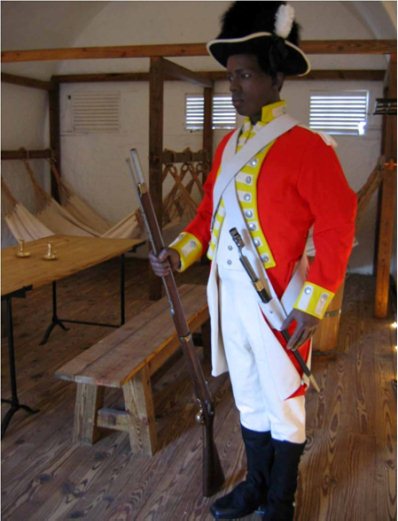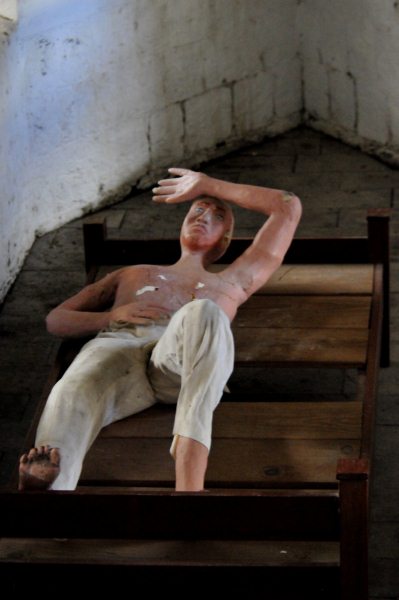Life at the Fort

Beez Neez now Chy Whella
Big Bear and Pepe Millard
Thu 24 Feb 2011 23:59
|
The
Citadel
  After taking in the spectacular views eight hundred feet up, we crossed the
dry moat and into the Citadel
           Once inside we found most of the rooms
restored, labeled as to what they would have been used for and laid out with loads of interesting information
Management and Maintenance of
the Fortress: During its greatest use during the Napoleonic Wars
(1792-1815), the Fortress was occupied by nearly 1000 soldiers (both white line
regiments and Africans of the West India Regiments), 200 wives and children of
officers, a dozen members of the civil staff as well as 100 or more African
slave workers. The top of the hill and its upper slopes were crowded with
buildings, huts, ramparts and batteries giving it the appearance of a small hill town. Such a community had to be
supplied with food, water, equipment and clothing - and the buildings had to be
repaired and new ones constructed. This was managed by a small team known as the
Respective Officers", usually consisting of the chief officers of Engineers and
Artillery and the storekeeper.
 Regiments were recruited to the "beat
of a drum". The poor, the desperate, or those seeking adventure joined up.
Others were convicted criminals escaping punishment or imprisonment by agreeing
to join up. Only six wives per hundred men posted were allowed. This left many
wives and families behind to become destitute. The first stage in the journey to
St Christopher was a long voyage in a troop ship across the Atlantic Ocean. Some
soldiers died of ill health along the way. On arrival, the welcome appearance of
land - of an Eden-like landscape - gave way to the reality of uncomfortable
quarters, boredom and the ever-present threat of disease. Recruits received
little training and may only rudimentary steps of drill. They had to learn
soldiering on the job.
 The 15th
East Yorkshire Regiment (The Snappers): The Regiment was raised
in 1685 as the 15th Regiment of Foot and saw early service in Scotland and
Flanders. In 1702 it formed part of the Duke of Marlborough's army and took a
prominent position in many battles including Blenheim and Ramilies. During the
Seven Years' War the Regiment took the fortress of Louisburg (1758) and was
present at Quebec (1759) when General Wolfe was killed. Further campaigns
followed in Martinique and the American War of Independence (1776-1778) during
this time the Regiment gained the nickname "The Snappers". The Regiment was
represented at Brimstone Hill in 1779 and again in 1782 when, in combination
with soldiers of the Royal Scots Regiment and 350 of the local Militia -
totaling less than a thousand men they held off the French for a month, but
eight thousand enemy soldiers saw them surrender with full military honours. The
Regiment served again at Brimstone Hill (but saw no action) during
1812-1815.
West
Indian Regiments - 'Africans in Redcoats': To overcome the
manpower and health problems among the European forces which diminished their
numbers considerably in the Caribbean, African slaves were purchased in Africa,
captured from slave ships or recruited from the plantations to serve in the
British Army. In 1795, the British established the first two black regiments,
commanded by British officers. Twelve such regiments were raised, but the
numbers fluctuated. They served British military interests in the Caribbean
(where they were awarded three Battle Honours) and also in West Africa.
Detachments of West India Regiments
(WIR) were stationed at Brimstone Hill from time to time, including the 4th WIR
in the mid 1790's and the 2nd WIR in 1851.
Soldiers of the WIR were equal to
white soldiers of other regiments, but West Indian plantation oligarchies did
not recognise such freedoms when a black soldier was discharged. They were
indeed opposed to their recruitment in the first place. Thus, in St Kitts in
1797, the local House of Assembly used a "trifling" disturbance among a few of
the 250 WIR soldiers garrisoned at Brimstone Hill (who became alarmed at a
rumour that they would be discharged and enslaved) to prevail upon the colonial
authorities to transfer the regiment to St Vincent.
The last WIR was disbanded in
1927.
  Slavery at Brimstone
Hill: Physical exertion under the tropical sun was considered injurious
to the health of Europeans. Instead, workers enslaved from Africa were used. The
building, expansion and maintenance of the Fortress on Brimstone Hill depended
not only on their labour but on their skills. They were miners, stone masons,
brick layers, plasterers, carpenters, coopers, plumbers and cooks. Initial
training in some of these crafts may have been from European specialists but
from this developed an on-going base among the Africans whether working for the
plantations, the Government or at the Fortress.
A Day in the life of a
soldier: In peacetime, daily life of the garrison was a regulated
routine, which left the white troops inside buildings and out of the sun, with
the African slave workers and troops of the West Indian Regiment when in
garrison, undertaking the more arduous duties outside, in fact after breakfast
most English troops lazed around smoking, drinking and playing cards. Breakfast
was a pint of cocoa and a piece of bread. Lunch called "dinner" was a meal
of either fresh (when available) a or salt meat boiled into a soup,
and eaten with yams or potatoes with addition of fruits bought from the local
peddlers. Some bread saved from breakfast might bulk the meal up a bit. From
dinner until breakfast the next day, a period of over eighteen hours, no further
food was provided, except what the individual soldier could provide for himself.
There was also a rum ration which would be supplemented with other bought rum.
This we suppose could be called a liquid diet.
Hospital care was provided at
Brimstone Hill, by a qualified doctor or semi-trained assistants, called
"mates". Doctors knew how to mend broken bones or cut off an arm or leg, but
they were unclear about how to handle disease, whose causes they little
understood. When taken ill and hospitalised,
a soldier was placed on a special diet of milk porridge for breakfast, meat and
bread for lunch and a pint of broth for supper. Madeira wine was sometimes given
to assist recovery but even if it were not, the soldiers sometimes had rum
smuggled to them. Yellow fever and malaria were believed to be spread by an
invisible substance or miasma, floating in the air and resulting from rotting
vegetation or from the swamps. The mosquito was as yet unknown as the means by
which these diseases were transmitted. Civilian staff or military officers who
were debilitated by the effects of disease sometimes asked for a leave of
absence in Britain to get their strength back. They were examined by a medical
Board at Brimstone Hill and if judged incapable of performing their duties, were
sent home. Apart from the twin horrors of yellow fever and malaria, other
conditions suffered by the troops were typhoid, rum poisoning, bowel and eye
infections and sexually transmitted diseases. When yellow fever and malaria
struck, unaffected troops were sometimes segregated from the sick staying out in
tents at the bottom of Brimstone Hill or sent to Basseterre.
Included among the contractors
services was laundering of the bed-linen for the garrison, once every six
weeks.
Disease, Illness and
Death: Many soldiers regarded a posting to the West Indies as a death
sentence - there was a reputation for catching fatal diseases such as
yellow fever and malaria. Death rates were six times greater than in Britain. At
any one time up to a third of the troops might be unfit for service due to
illness. Sedentary life, boredom and the abuse of alcohol may have contributed
to these high rates. Many cases of yellow fever may have been
misdiagnosed alcohol poisoning. African troops of the West Indian Regiment
were more resistant to the diseases which so affected the
Europeans.
   Punishment: Minor
offences such as untidiness, loss of military property etc. could be punished
administratively by the Commanding Officer. This might lead to loss of pay.
Drunkenness or fighting among men might be punished by flogging, as well as by
imprisonment. The civilian staff employed in the
garrison could also be disciplined by a panel of officers and if necessary
dismissed from the services. The whirligig, a
spinning cage in which the prisoner was placed and rotated until violently and
physically sick. Good old flogging was used and another punishment was to sit
'On the Horse' - a wooden horse with a pointed saddle. The soldier with hands
tied behind their backs was sat up on the 'pointy bit' and weights were added to
their ankles. Don't, my eyes are watering.
Assault on a senior rank, murder and sex with an animal were crimes that carried
the death sentence.
 Religious worship
was an integral part of civil and military life, being seen as the basis for
society itself. In the army this involved practice of Christianity under the
Established Anglican Church. But to the Commander in Chief, religion was as much
about reinforcing a sense of obedience to the authority of the King and his
Officers as it was about safeguarding spiritual well-being of the troops and
their route to heaven. Attendance at Church parade on Sundays was
compulsory.
    Meanwhile Bear is
trotting around listening to his lady friend
ALL IN ALL A
FASCINATING INSIGHT
UNUSUALLY DETAILED ACCOUNT OF WHAT IT WAS LIKE TO BE A
SOLDIER HERE
|